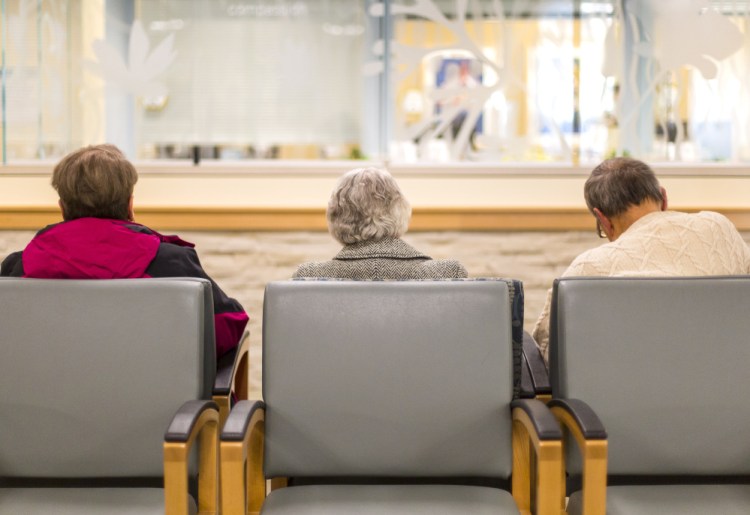The doctor will see you soon. Really.
The time spent sitting in a waiting room at doctors’ offices has shortened in Maine and nationally in the past year, even as more people got health care insurance under the Affordable Care Act.
“From a patient’s perspective, their problem is the most important problem. We try to respond to that urgency and need,” said Andrew Russ, M.D., medical director of primary care with Lincoln Medical Partners in Damariscotta. “We’re not as accessible as families want us to be but we’re getting there and we’re actively working on it.
Maine ranked third best in terms of the shortest average wait time, according to a 2015 report by New Jersey-based health care firm Vitals. At 15 minutes and 56 seconds, Maine came in behind New Hampshire and Wisconsin for short wait times. Still, the wait in Maine was shorter than the national average wait time of 19 minutes and 16 seconds. The worst state? Alabama, with an average wait time of 23 minutes and 25 seconds, according to Vitals.
Compared with the 2014 survey, Maine trimmed 11 seconds off its wait time and the national average wait dropped by one minute, according to Vitals.
A variety of factors have come into play to improve wait times, including new efforts to improve patient satisfaction, electronic records that speed paperwork and chart transfers, and behind-the-scenes planning and better division of care among nurse practitioners, physician assistants and doctors so patients see the right caretaker the fastest.
Maine also has a higher-than-average concentration of doctors, but mostly in urban centers rather than rural locales. Maine ranked seventh in terms of density of doctors. In 2012, Maine had 307.3 physicians per 100,000 residents, according to the Association of American Medical Colleges, which was higher than the national rate of 260.5 physicians per 100,000 people.
Medical practices began paying more attention to wait times after patient surveys listed “delays” among chief complaints and as competition for patient dollars intensified, doctors said.
“The single most effective thing we do is the morning huddle,” Russ said. “We strategize on how to tackle the day and plan for special cases and special needs.”
The meeting consists of a nurse, a medical assistant, schedulers and doctors who run through the list of patients coming in that day to determine what paperwork and tests are needed, what potential bottlenecks might occur, which patients need special accommodations such as wheelchairs, or where there might be openings in the schedule to fit in emergency cases, Russ said.
 Southern Maine Health Care’s internal medicine practice in Biddeford studied how it managed patients from the moment they walked into the office to the time they left. They realized the practice had different procures depending on who logged in the patient or who walked the patient back to the exam room or which doctor was providing care.
Southern Maine Health Care’s internal medicine practice in Biddeford studied how it managed patients from the moment they walked into the office to the time they left. They realized the practice had different procures depending on who logged in the patient or who walked the patient back to the exam room or which doctor was providing care.
“Sometimes it was anecdotal. We would hear things like ‘Why isn’t my time as valuable as the doctor’s?'” said Karen Waycott, director of primary care operations at Southern Maine Health Care. “New systems and procedures and planning help us be more respectful of everyone’s time.”
The practice adopted standardized procedures for every action, making training easy and consistent, and the patient experience “much smoother,” said Waycott.
Southern Maine Health Care has an advisory group that includes patients, doctors, nurses and support staff who suggest improvements.
“The improvements are coming from people who are living and breathing the systems everyday, the changes came from the bottom up – not the top down,” said Lori Cote, practice manager at Southern Maine Health Care Internal Medicine in Biddeford.
Waycott said Southern Maine Health Care tries to communicate better with patients by proactively explaining if and when a doctor is running behind schedule and offering to reschedule.
Paying attention to wait times isn’t just better for patient care and satisfaction rating, it’s also good business, doctors said.
“In this part of the country, we don’t have to compete against Wal-Mart clinics or a CVS walk-in service yet. But we might at some point. We have to be more responsive,” Russ said.
Send questions/comments to the editors.


